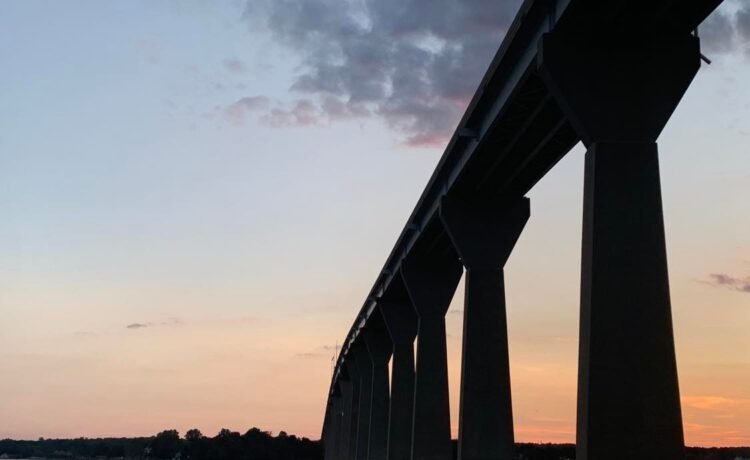
SOLOMONS, Md. – Why isn’t there a fence, net or other safety barrier on the Governor Thomas Johnson Bridge? This question occasionally resurfaces after a tragedy or brush with death. To find the answer, we have to understand the bridge.
Built in 1977, the Governor Thomas Johnson Bridge is a 1.4-mile long span of Maryland Route 4 (MD 4) that connects Calvert and St. Mary’s Counties. The bridge is about 160 ft high at its tallest point to provide a 140 ft navigation channel in its main span for US Coast Guard vessels, although it’s exceedingly rare for ships of that size to pass under the bridge.
As the primary link between Calvert and St. Mary’s, the bridge sees over 25,000 vehicle crossings on an average day. The Maryland Department of Transportation State Highway Administration (MDOT SHA) is responsible for maintaining the Thomas Johnson Bridge.
In 2013, Governor Martin O’Malley signed the Transportation Infrastructure Investment Act, which apportioned $1.2 billion dollars for highway and transit projects across the state. This included $20 million to design a new Thomas Johnson Bridge. The planning phase for this new bridge was completed in 2015. The project is now on hold in the design phase due to budget constraints. Construction dates are yet to be determined according to the SHA.
In December 2021, answering requests from the Maryland General Assembly Senate Budget and Taxation Committee and House Appropriations Committee, SHA published their findings on suicide deterrent systems (SDS) and best practices regarding their installation.
SDS are measures taken to prevent suicide attempts or protect people who attempt suicide. These can include physical measures like fences, walls and nets on bridges as well as softer measures like signage with crisis helplines, video surveillance and guard patrols.
The 2021 report states that “Currently, the applications listed do not specify assessing the prevention of suicides at various locations and only provide guidance on evaluating the potential for ‘overhead bombing’ of traffic or pedestrian walkways that may be located underneath the bridge. As a result of this review, the manual will be updated to include parameters and guidance for evaluating bridges for the possible need to install a barrier to prevent the risk of suicide.”
Citing medical journals such as the American Journal of Psychology and specialized organizations like the National Suicide Prevention Lifeline, SHA reported to the committees that barriers to physically attempting suicide such as fences are walls were more effective SDS than helpline signage or callboxes. Safety nets were found to be effective deterrents as well.
As part of this research, MDOT SHA reached out to its counterparts in Connecticut, Delaware, New Jersey, New York, Pennsylvania and Virginia. Most of these states had no official guidelines for installing SDS, instead evaluating bridges and overpasses on a case-by-case basis.
Delaware’s Department of Transportation installed signs near ten bridges at the request of Delaware’s Department of Health and Social Services. At the Delaware Memorial Bridge where several suicide fatalities had occurred, “system monitoring devices” and barriers were installed to prevent further incidents.
The Pennsylvania Department of Transportation installs fencing on new bridges that allow public access. In addition, fence installation is considered for existing bridges if there is a suicide attempt or if softer measures such as signs and surveillance have not decreased the instances of suicide attempts.
MDOT did not hear back from the New York or Virginia Departments of Transportation before publishing this report for the Maryland State Government.
MDOT SHA concluded their 2021 report by saying “the current best practice would [be] evaluating the installation of a preventive barrier on any new bridge that has a vertical clearance of over 40 feet or during the development of any project, new construction, reconstruction, or repair. The following questions should be considering in this evaluation or assessment:
• What access is provided to pedestrians?
• Is there a local medical facility that provides mental health services located nearby?
• Is the bridge significant or have some notoriety to attract attention to it?
• Are there other bridges in the vicinity that have a history of suicides by people jumping from them?”
Between January 1, and March 15, 2022, there were four suicide attempts at the Thomas Johnson Bridge. This prompted the SHA to install signs advising passersby of a crisis hotline and evaluate what more could be done to protect Marylanders. In August 2022, MDOT SHA published Governor Thomas Johnson Bridge: Evaluation of Suicide Deterrent Systems.
Eight SDS alternatives were considered in this report. Five were physical measures intended to prevent or interrupt suicide attempts, and three were non-physical measures meant to dissuade individuals from or intercept them during a suicide attempt. These alternatives were labeled 1-8, with no particular preference implied by the numbering: 1. A physical barrier behind the existing concrete parapet. 2. A physical barrier on top of the parapet. 3. Netting near the roadway surface. 4. Netting well below the roadway surface. 5. Hybrid barrier and netting. 6. On-site security monitoring. 7. Remote video monitoring. 8. Callboxes and signage.
Alternatives 6, 7 and 8 were removed after initial evaluation because “MDOT currently uses a combination of the non-physical deterrent systems throughout the entire transportation system,” according to the report. Alternatives 1-5 moved on to evaluation for safety, structural, operational and regulatory concerns.
Once every 12 months, SHA inspects the bridge to ensure that it’s safe. The spans or segments near the center of the bridge contain fracture critical girders. If any of these girders were to fail, the spans they support would likely collapse.
MDOT SHA uses cranes on Aspen Aerial A62 under-bridge inspection vehicles to bring inspectors from the roadway to these critical components so that they can conduct hand inspections. The cranes on these trucks have an eleven foot maximum height clearance. The tallest proposed barriers in this preliminary evaluation were ten feet eight inches tall. This sliver of clearance might suffice for most spans of the bridge, but not those with fracture critical elements, which require more thorough inspection and more movement from the crane arm.
These issues with inspections could be mitigated by installing removable panels in the SDS, using existing maintenance platforms on the bridge or changing from cranes to rigging or Society of Professional Rope Access Technicians (SPRAT) rope-access techniques. The net alternatives would make inspection by crane from the roadway impossible, necessitating the use of rigging and SPRAT techniques. These access issues would also affect routine maintenance and repairs to the underside of the bridge. Barriers behind or on top of the parapet would likely have a small effect on snow and ice build up.
Any installed SDS would also need to be inspected and maintained itself. All alternatives would need regular assessment near the bridge’s expansion joints to ensure alignment and across all sections to ensure mesh elements are at the proper tension. Barriers could be affected by vehicles colliding with the parapets, and nets would need to be cleaned of debris from birds or litter from passing vehicles.
Before beginning work on any SDS and while that work is ongoing, the SHA would need to fulfill certain regulatory and statutory obligations. These could include acquiring permits from the US Coast Guard, Maryland Department of the Environment, Federal Aviation Administration, or U.S. Fish and Wildlife Services, depending on the alternative selected.
Total construction costs for alternatives 1 and 5, with barriers behind the parapet, were estimated to be around $9.9 million in 2022 dollars. Alternative 2, a barrier on top of the parapet, would be about $8.5 million. Alternatives 3 and 4, the netting either at or below the roadway, would be around $13.3 million.
SHA estimated designing SDS barriers would take 16 to 18 months. Netting alternatives could take 18 to 20 months to design. Construction on any SDS would take between 10 and 14 months, assuming that construction would only be performed on weeknights but would be allowed to continue November 1 to March 31, which is usually off limits for SHA construction.
“This seasonal restriction limits construction activities to a time of year that is generally considered a winter shutdown period for construction,” the report says, “due to the anticipated cold temperatures and the increased likelihood for inclement weather and lost workdays. The cold temperatures during this time of year are also not conducive to certain anticipated construction activities, including existing bridge parapet repairs, anchor bolt installation operations, or any potential painting operations. The implementation of the seasonal calendar restriction on this project would significantly increase the total construction duration, likely extending construction activities by an additional 10 to 12 months.”
During this construction at least one lane of the Thomas Johnson Bridge would have to be shut down to give construction crews enough space to work safely. Given the inconvenience for local drivers, SHA did not consider closing both lanes of MD 4 to hasten construction.
“Additional economies and a shorter period of construction can be realized if sustained daytime lane closures and/or weekend work is permitted,” the report says. “If the normal seasonal restriction is imposed, it will likely take an additional 10 to 12 months for construction to be completed.”
The work would cost millions of dollars, could take two to three years to complete and might be made redundant when planned renovations of the Governor Thomas Johnson Bridge finally begin. But those aren’t the only numbers at play.
According to the Maryland Department of Health, the suicide rate in our state is around one in 10,000. In about 4% of those cases, someone tries to end their life by jumping or falling. There are over 1.9 million people in southern Maryland. Statistically, we can expect approximately 190 suicide attempts in our communities this year, seven of which might be at places like the Governor Thomas Johnson Bridge.
If you or someone you know is in crisis, call or text 988. The 988 Suicide & Crisis Lifeline offers free and confidential support to people in need.
This is a developing report, and the Baynet will update this article as more information becomes available.
Contact our news desk at news@thebaynet.com















